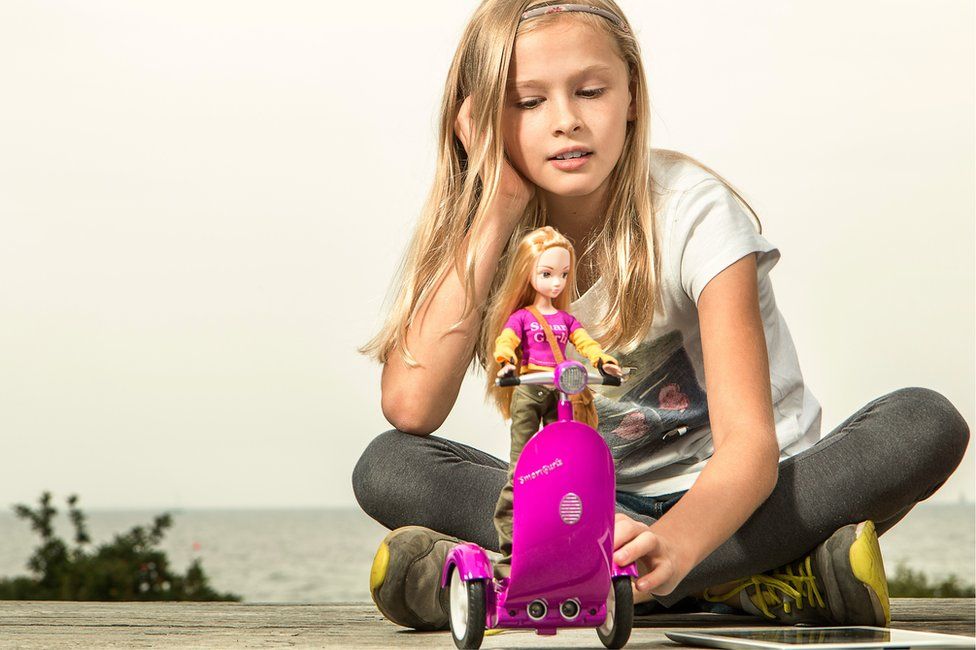Can hi-tech toys be fun and educational?
- Published

It used to be that a simple doll or action figure would be a welcome surprise when we tore open our Christmas presents.
But now that today's kids grow up in a world saturated with technology, do they expect their toys to be a bit cleverer too?
Famous toy retailer Hamleys certainly thinks so, predicting a bumper Christmas for interactive tech toys.
So what can we expect? Robots with minds of their own? Drones flying around bugging the whole family?
Reyne Rice, chief executive of ToyTrends, actually thinks it's the simpler, educational tech toys that will be the real winners this Christmas.
"The interesting part is that the products and manufacturers that succeed use technology to enhance the play value of the products they bring to market," she says.
For example, Danish company SmartGurlz wants to encourage girls to code.
Their fashion dolls ride around on Segway-style scooters called Siggy Robots that can be programmed via an app. Girls aged 6-12 can use the app to make the scooters spin around, zig-zag or zoom along in a straight line.
"I was looking for toys to inspire my daughter and help her gain confidence in maths and spatial reasoning," says SmartGurlz founder and chief executive Sharmi Albrechtsen.
"Unlike her male cousin, who had hundreds of types of Legos, robots, helicopters, and drones to choose from, there was very little in the toy store that gave her messages outside of fashion, make-up, horses and princesses."
Via the SmartGurlz SugarCoded app, girls learn how to code their Siggy Robots to carry out missions and adventures. They have to read maps and find imaginary items on the floor to help their characters complete their missions.
Even younger kids can learn the basics of programming with a Fisher Price toy called Code-a-pillar, which Hamleys predicts will be a bestseller this Christmas.
Kids from three years upwards can arrange and rearrange the segments of the Code-a-pillar to make it move in different ways and directions. This teaches them problem solving, planning, sequencing and critical thinking, the toy maker says.
Google has also been getting in on the act, coming up with Project Bloks, an open hardware platform to help kids develop computational thinking.
It's a collaboration with Paulo Blikstein, director of the transformative learning technologies lab at Stanford University, and Ideo, a design company.
By arranging the blocks in a certain sequence kids will be able to control a "microbot" and make it draw, turn and move. Ideo is currently testing a coding kit version of the system with children and schools, but don't expect them to be in the shops just yet.
Bethany Koby, founder of Technology Will Save Us, an organisation aimed at encouraging learning through inventive games, still thinks that the toy industry - worth about $25bn (£20bn) in the US and £3.2bn in the UK - has a long way to go when it comes to adapting to new technology.
"The toy industry is one of the most powerful industries in the world," she says. "It shapes and moulds some of the most important early years of people's lives through education, play and new experiences.
"It's surprising to see that a lot of the toys we see today still don't use technology in a very productive or creative way - toys should be able to prepare and empower kids, they should help to shape their futures."
One trend has been simply to reconfigure adult tech - smartphones and smartwatches - for kids.
"This is a 'trickle-down' effect - what's new and innovative in the adult world is often introduced into the toy market within 12 to 18 months," says Ms Rice.
"Kids want to role play and also use the same technologies that they see their role models, such as parents or celebrities, using."
But even play with educational tech toys needs to be controlled, Ms Rice believes.
"Parents must be responsible and make sure children are playing with more traditional toys too," she says.
"The traditional toys give children social awareness and help to build relationships - and we mustn't forget that."
This is where toys like Yibu come in, bridging the gap between the real world and the digital world.
The game, developed by Dutch company Frog design, includes five wooden toys, which are embedded with sensors. By moving the toys around and placing them in different situations, kids learn how temperature, sound, light direction and rotation affect digital characters displayed on a tablet computer or smartphone.
The characters experience environmental challenges and can be helped on their journey depending on how the child uses the toys.
Even books are incorporating technology these days.
My Kingdom Books, for example, has taken pop-up books a step further using augmented reality (AR). The personalised story books feature characters that appear to come to life when viewed via the AR app on a smartphone or tablet.
"Introducing augmented reality to a children's book gives children the opportunity to engage with a modern-day pop-up book, encouraging imagination and creativity when the book springs to life in front of them," claims Amile Samarakoon, founder of My Kingdom Books.
"By combining technology with traditional print we're able to create content that can change as the child develops."
So technology is undeniably infiltrating the toy world, but the jury is still out on the best ways it can be used to enhance learning through play.